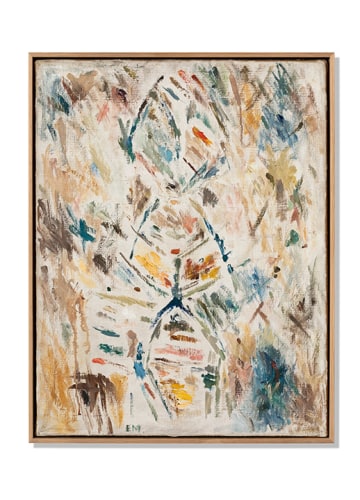

If museums are serious about globalizing their collections, it won’t do just to pick out a few Africans or Asians or Latin Americans whose art superficially resembles what the West already approbates. Art history has to be reconceived as a perpetual migration of artists, images and ideas — across oceans, across decades. A sterling case study awaits in the upstairs space of Aicon Gallery, displaying the lean, precise, calligraphic abstractions of Ernest Mancoba (1904-2002), a South African painter who spent his career in Denmark and France. Defying past and present received ideas of nationality and identity, these delicate abstract compositions resound as the work of an artist committed to his full liberty. Ernest Mancoba’s “Untitled 2,” circa 1965, at Aicon Gallery. Ernest Mancoba and Aicon Gallery Mancoba was born in Johannesburg in 1902 and studied art at an Anglican school; his early figurative sculptures, not in this show, are arguably the first “modern” artworks by a Black South African. The sensitive allover abstractions on view here were made in European exile (he left before apartheid was instituted in 1948), and feature thickets of lines orchestrated into discrete zones of color. Often scaled like portraits, they almost always incorporate a few strokes that hint at a stick figure amid soft, syncopated slashes of ocher, mauve, teal or gray; the use of untreated canvas, too, give the compositions the melancholy delicacy of a muted trumpet solo.
Drawings and paintings on paper are sparer still, and reveal outlines of bodies whose angled stylization put me in mind of Central African reliquary statues. The later works on paper here, some from his tenth decade of life, appear like sentences of black asemic glyphs over colored slashes and Xs.
This show at Aicon includes 18 paintings and works on paper by Mancoba, handsomely installed against peach-colored walls, and paired with bronze sculptures by his wife, the Danish artist Sonja Ferlov Mancoba. Her bronzes of roughly finished metal, which can recall masks or totems, show the enduring influence of African sculpture on European modernism — and reaffirms that both husband and wife were working in a postwar Paris where a clean division of “African” and “European” aesthetics could not be made. The real urgency here, though, remains Ernest Mancoba’s abstractions. They ought to be in every serious modern art museum: not as a token of “African” modernism, but an exemplar of forms in motion.
JASON FARAGO